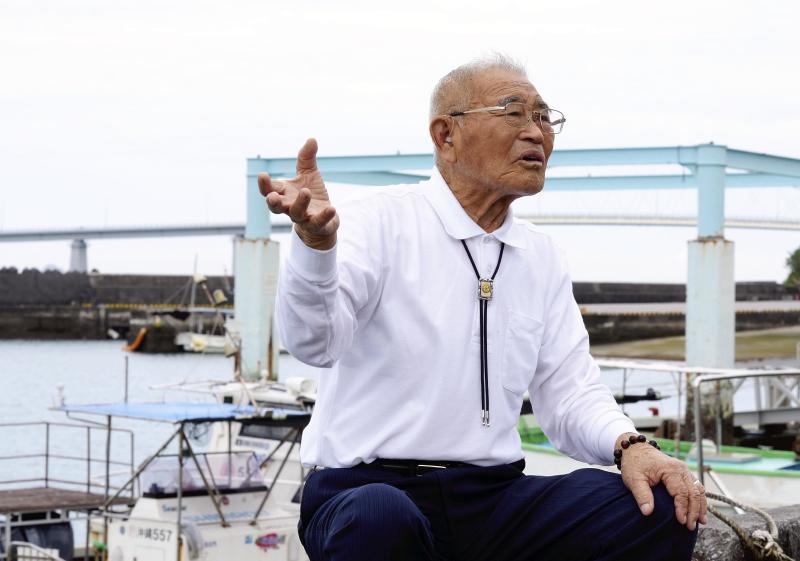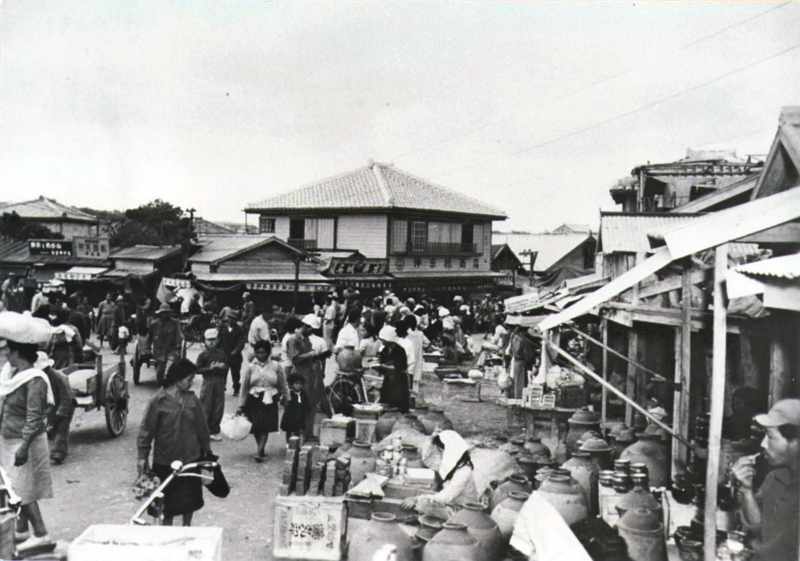
Hideo Nakamura talks in June about his experience as a diver, at a port overlooking the sea where ships were sunk in Motobu, Okinawa Prefecture.
1:00 JST, June 24, 2022
Amid the devastation following World War II, many residents of Okinawa found a source of income in the ammunition fired during the “Typhoon of Steel” of naval bombardment during the Battle of Okinawa and the abundant supplies at U.S. military bases.
Hideo Nakamura of Motobu in the prefecture volunteered during the war to train as a naval aviator. He was in Wakayama Prefecture when it ended, waiting to be sent on a mission. After he returned to Okinawa in 1947, he worked as a truck driver at a U.S. military base in the central part of Okinawa’s main island.
Local people did not have enough food after the war ended, as their land had been taken by the U.S. military and the prefecture lacked industries. Many residents stole U.S. military supplies such as army clothes and canned food and sold them on the black market. Angry at suppression by the Occupation forces, people gave those who stole the approving nickname of “senka agiya,” meaning “those who achieve results in battle.”
Nakamura, now 92, was one of those who earned his daily bread this way.
“The U.S. military bases had everything. I had no choice if I wanted to stay alive,” he said.
When the Korean War began in 1950, the demand for metal increased both in and outside Japan. Metal recovered from ammunition from the Battle of Okinawa and sunken ships became an important export item. Nakamura, who is from a fishing family, quit his job at the military base and began diving in the sea in the northern part of the prefecture.
There were a number of warships sunk by U.S. forces at the bottom of the ocean. Nakamura and his friends dived in turns and sawed off yellow brass from the screws. They also used ropes to pull up sunken shells, until their boat was filled with them.
According to prefectural documents and other sources, about 200,000 tons of ammunition was used by the U.S. military in the Battle of Okinawa, with about 10,000 tons of it left unexploded. A total of 338 people died in related accidents in the 1950s, some of which occurred while they tried to recover unexploded ordnance.
However, “I couldn’t even afford to feel afraid at that time,” Nakamura said.
Nakamura now relates his experiences to others, and was to give a lecture at a local elementary school and other places ahead of Okinawa Memorial Day (June 23). In his presentations, he talks about the many crew members who were lost on sunken warships and calls for not repeating war again.

The Tsuboya district, home to many stores and crowded with people, is seen in 1950.
Among the people confined in camps after the U.S. military landed on the main island of Okinawa in March 1945, residents of the Tsuboya district of Naha were the first allowed to return to their homes. The district has been known for its pottery since long before the war, and about 100 potters returned home in November 1945.
Tsuboya miraculously escaped significant damage, and climbing kilns and pottery materials and tools remained. Potters made china bowls and other tableware for the people confined in camps, who were using empty food cans as tableware.
When residents began returning home, there was demand for water jars and funeral urns, and potters also made roof tiles as the reconstruction of residential buildings started in earnest.
Fumio Shimabukuro of Naha, 84, remembers his late father working silently. “I think he was determined to deliver as fast as he could the bowls and vessels that people needed in daily life,” Shimabukuro said.
A few years after the potters started to return, restaurants and playhouses were established in the district. As the area expanded, a nearby devastated area became Kokusaidori street, one of the most popular tourist spots in Naha today.
“After the war, we rose up from the devastation and rebuilt. I want to pass this strength on to future generations,” Shimabukuro said in a pledge to his ancestors, who built the foundation of the island, 50 years after Okinawa’s return.
"Society" POPULAR ARTICLE
-

M4.9 Earthquake Hits Tokyo, Neighboring Prefectures
-

Israeli Tourists Refused Accommodation at Hotel in Japan’s Nagano Pref., Prompting Protest by Israeli Embassy and Probe by Prefecture
-

M7.5 Earthquake Hits Northern Japan; Tsunami Waves Observed in Hokkaido, Aomori and Iwate Prefectures
-

Tsukiji Market Urges Tourists to Avoid Visiting in Year-End
-

M5.7 Earthquake Hits Japan’s Kumamoto Pref., Measuring Upper 5 Intensity, No Tsunami Expected
JN ACCESS RANKING
-

Tokyo Economic Security Forum to Hold Inaugural Meeting Amid Tense Global Environment
-

Keidanren Chairman Yoshinobu Tsutsui Visits Kashiwazaki-Kariwa Nuclear Power Plant; Inspects New Emergency Safety System
-

Imports of Rare Earths from China Facing Delays, May Be Caused by Deterioration of Japan-China Relations
-

University of Tokyo Professor Discusses Japanese Economic Security in Interview Ahead of Forum
-

Japan Pulls out of Vietnam Nuclear Project, Complicating Hanoi’s Power Plans























